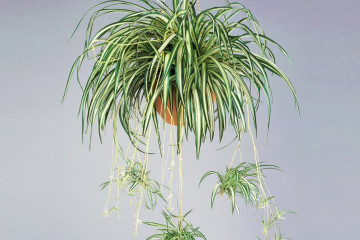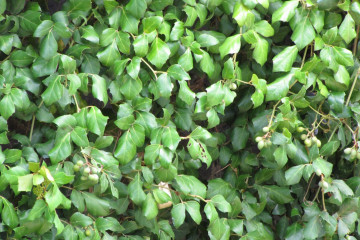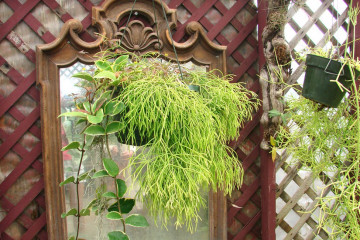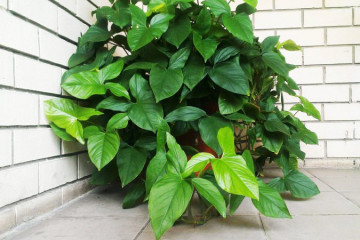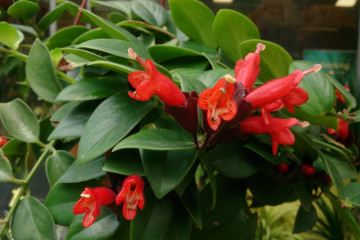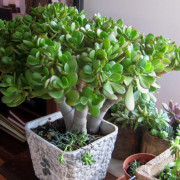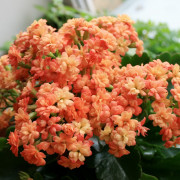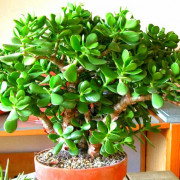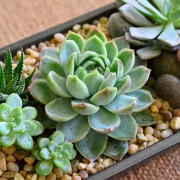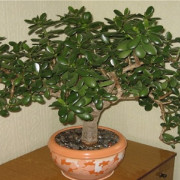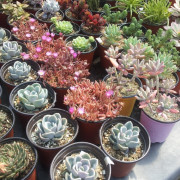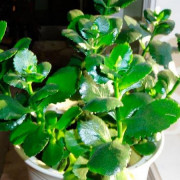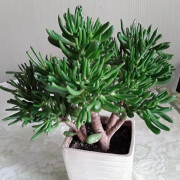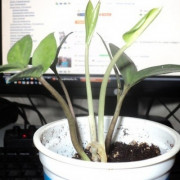Sansevieria - home care and reproduction
Content:
Sansevieria is known in 70 species, most of which are native to Africa. According to one version, the botanical name honors the name of the Neapolitan prince San Severo, who lived in the 18th century, an encyclopedic intellectual and patron of gardening. In subtropical countries, wild sansevierias are part of the landscape; in southern Florida, they are planted as hedges; in southern Europe, they decorate gardens and parks; in the Russian temperate climate, they are used as houseplants.
Sansevieria home care
Sansevieria belongs to the Asparagus family, subfamily Nolinoideae. Thanks to its rhizome and succulent leaves, it is ideally adapted to the arid regions of the subtropics. In a living space, such conditions are not at all difficult to provide. Most mistakes in the care of sansevieria are excessive watering and feeding. However, it is rather difficult to destroy it; in the end, sansevieria can please flower growers for a very long time. The clear profile of an exotic plant suits very well modern interiors.
Lighting
Because of the bright sunlight that sansevieria loves, caring for it at home involves creating good lighting. Only a few species prefer a partially shaded area.
The plant can withstand high temperatures very well. In summer, the 30-degree heat is not a problem for him. Sansevieria tolerates low temperatures worse, but 13-18 ° C in winter is quite acceptable.
At the same time, the plant is very modest, even cool, dry and shady places suit it. However, the deviation of living conditions from optimal ones will be expressed, first of all, in slow growth.
If there is not enough light, the leaves become thin, prone to bending. In this case, the pot should be immediately moved to a sunnier place. Additional artificial lighting with fluorescent lamps will also be beneficial.
How to water sansevieria
The irrigation regime also belongs to the peculiarities of home care for sansevieria. Watering the flower should be like succulents, that is, plants that create a supply of moisture in the leaves. Irrigation is carried out after the substrate has dried by 1 cm and a little more in depth. With excessive watering, the root begins to rot.
In winter, the frequency of watering is reduced to about 1 time per month, depending on the temperature inside the house. The warmer it is, the more often the soil should be irrigated.
Spraying is not required for the plant, only to remove dust from the leaves.
Fertilizers for cactus, diluted in water for irrigation, are best suited for feeding. The dosage should be reduced to half the recommended dosage. As fertilizer, you can use infusion of leaf compost.
In the first year after purchase or transplantation, it is enough just to water sansevieria with clean water, since fresh soil contains enough nutrients.Then, from April to September, you can add fertilizer to the irrigation water every 4-8 weeks. For sansevieria with a large number of leaves, preparations with a predominance of nitrogen are suitable, which contributes to the development of green plant organs.
When bloom comes
Sansevieria sometimes blooms in adulthood, but very rarely. These white, yellow, pink, or greenish flowering panicles are more likely to appear in early spring, with each shoot blooming only once for 1 to 2 weeks. In some species, the flowers are very fragrant.
If the flower is pollinated, then reddish berries containing seeds appear. Unlike many other succulents, the shoot of this flower does not die off after flowering, it continues to grow.
Transplant and soil
Sansevieria flower requires a breathable plant substrate. The land should provide good moisture permeation. An excellent choice would be soil for cacti. When self-compiling the substrate, it is necessary to mix leaf and sod land, leaf compost (no more than 10%). The third part of the soil should be sand in order to increase the permeability.
Although sansevieria grow slowly, the leaves of some species can reach 1 m or more, overgrown roots sometimes destroy the pot.
Due to its slow growth, sansevieria is transplanted only once every few years. When the roots are visible on the surface of the substrate, then the time has come. The downward bending of the leaves also indicates the need for replanting, since the rhizome no longer provides the aerial part with sufficient support.
The best time to transplant is March, when the resting phase ends. In a new place, sansevieria will come to life and actively grow.
Brief transplant instructions:
- Prepare a new pot by filling in a layer of drainage (pebbles, brick chips, etc.);
- Remove the plant from the previous flower container along with the soil. In order for the earthen lump to better lag behind the walls, you can walk along them with a blunt narrow object;
- Gently shake the earth from the rhizome, you can remove it with a warm gentle stream of water.
- Pour a little substrate on the drainage layer and place the plant;
- Top up with soil and press lightly.
Reproduction of sansevieria
Three methods are used to propagate sansevieria:
- growing from seeds;
- division of the root;
- use of cuttings.
The first method is practically not used due to the difficulty of obtaining seeds, because the plant blooms extremely rarely. If, nevertheless, it was possible to get the fruits of sansevieria, the seeds are taken out of the berries and dried. Then inoculated onto a sterile, slightly moist substrate. It is recommended to cover the container with seeds with foil and place in a warm place. Here growers face new difficulties, since the sprouts often develop poorly or can simply rot in the soil if the moisture is excessive. Daily ventilation is required.
There are much simpler and more reliable breeding methods. One of them is the division of the rhizome, which is convenient to do during transplantation. Young sansevieria will grow completely identical to the mother plant.
Procedure:
- Cut the rhizome with a sharp disinfected knife into pieces, each of which should have leaves and roots. Make sure that in species of sansevieria with formed rosettes, each separate part has a rosette;
- The resulting parts are planted in pots with a substrate and kept at a temperature not lower than 20 ° C until they take root. When new leaves appear, the roots are already well developed.
In addition to cutting the rhizome, it is possible to separate the resulting lateral shoots or daughter rosettes. They must have leaves at least 5 cm long and the first roots.
How to root sansevieria without roots
For this, the most popular breeding method is used - rooting cuttings from leaves.
Procedure:
- The leaf of the mother plant is cut off with a sterile knife close to the soil surface. If it is small, you can use whole, long leaves are cut into several pieces at least 5 cm long;
- The cuttings are dried for several days, and the cut, which will be immersed in the soil, is processed by Kornevin to stimulate root growth. For leaves cut into several parts, you need to pay attention to the direction of growth, otherwise it will not be possible to root the cutting.
- Plant the pieces of the leaf in the ground, deepening it by 1.5-2 cm. At the next stage, you need to know how to care for the sansevieria, its leafy cuttings. Planting substrate should be moist, but not wet. He is constantly kept in this state;
- The container with cuttings is placed in a warm, bright place at a temperature of at least 20 ° C. Better if it is around 25 ° C. You can cover it with a film on top, but do not forget about airing. It will take patience. More than a month may pass before the first shoots appear;
- As soon as the shoots appear on the surface, the leaf cutting itself can be removed and after a couple of months the young plants can be planted in separate containers.
Sansevieria Laurenti
In Latin, Sansevieria Laurentii is called Sansevieria trifasciata laurentii. It is called three-lane because of the alternating dark green and light green stripes, as well as a golden border on the leaves. It is a very resistant plant with a creeping rhizome, from which erect straight, fleshy, slightly concave leaves up to 1 m high.
Flowering most often occurs during the summer season with maximum sunshine. The flowers are collected in 4-centimeter brushes, have a pleasant aroma and pale green color. Sansevieria Laurenti is a hybrid variety. Sometimes, during reproduction, it returns to its derivative roots.
Sansevieria Munshine
In Sansevieria Munshai (Moonshine), the leaves are wide, elliptical, silvery-green, form a low-growing vase-shaped rosette and grow spirally. Survives under the most adverse conditions.
Like all sansevieria, it is highly sensitive to over-watering. It is especially necessary to ensure that irrigation water does not accumulate in the outlet. This can lead to the onset of putrefactive processes and diseases.
Unjustified pruning can cause great harm to Munshai sansevieria, it will stop growing. Only damaged and dried leaves should be trimmed completely.
Sansevieria Futura
This newly bred plant has a very elegant look. Its dimensions are small - up to 30 cm in height. This is a close relative of the Laurenti variety with a similar color of leaves, but they are wider and shorter (length - up to 50 cm, width - up to 10 cm), collected in a rosette, forming a bizarre shape.
Caring for the Futura sansevieria is no different from caring for the Laurenti variety. In order for the drawing on the leaves to look bright, the plant needs good lighting.
Sansevieria Compact
Another hybrid based on Sansevieria trifasciata, with short and wide leaves, but similar in color to Laurenti. They are collected in an outlet and seem to be tousled by the wind, which looks funny. The compact is more difficult to care for than other hybrid varieties.
It requires good illumination, better adherence to the irrigation regime, protection from low temperatures (less than 13 ° C) and drafts. With mistakes in care, it can start to hurt.
Sansevieria cylindrical
One of the most exotic species in the large Sansevieria family. Characteristic in his description are unusual twisted leaves, the shape of which resembles cylinders. Tubular leaves with transverse contrasting stripes can form fancy braids and grow from 40 to 150 cm in height. The look is very much appreciated by designers, as it gives each interior a unique flavor.
With good care of the cylindrical sansevieria, flowering can be observed, which occurs if the plant is sufficiently lit. On a peduncle up to 1 m long, small white flowers with pinkish edges appear - the most beautiful among the flowers of the other varieties of sansevieria. The peduncle at the top has a beige color with a pinkish tint.
Sansevieria is a plant that can be cultivated by any florist, including those with an absolute lack of experience and special knowledge. Even shaded areas can be decorated with some species. The flower is allowed to leave the apartment, leaving it for some time without regular watering. If you place the plant in bright sun, then its color may change; with a variegated color, the stripes will become more pronounced. However, this should be done carefully so that the leaves do not get burned. Sansevieria is ideal for those who would like to grow indoor plants but have little time to take care of them.










